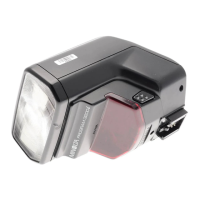Flash Range
'SO
25 50 1002004001.000
~,I
II
-
"
~
~I~ ~~ 32
•..•..•..•
~
,
,
,
<,
~
11 1622 32
,,~
I 1 I I
-
"
!','
',6
'r
l'
-_R0-.
<,
~
,
6
V','
'p
'l-
3'
<,
~
<,
:::-...
,05,6
V','
'p "
<,
~
,8
4p 5,6
!','
'6
'-"-"-
2,02
j
84
j
O Si
6
V
11 .•.
<:
~
14 Z
j
02
j
8 4
j
O 5
1
6 ~ .•.
-;
<,
:::-...
.~
'4',0
'18
',°
5,6
-
"::
~
"::
14 ',0
'18,
°
-r-e-,
<,
---'~r1
r'
~
<,
~
r:
"'-~
~
---.-...:::
~
\)'
~
\2,
28
<:
~
85=lens
<,
~
SS-OS
Sllnr'lens
-,
I
<,
28n"mlcns
<,
"",",.,,,
,
,
0.3 04 0.5 0.1 3 4 5 6 7 8910
r~
To determine the appropriate flash range from the
graph above, find the selected lens aperture on the ver-
tical line for the film speed (ISO) being used. Imagine
a horizontal line drawn across the graph from this
point, The minimum subject distance is indicated by
the point where the horizontal line crosses the mini,
mum distance line for the appropriate lens focal length.
The maximum subject distance is indicated by the
point where the horizontal line crosses the line for the
appropriate lens focal length and flash power level.
CDNormal power level
@ "Lo" power level
@ Minimum distance
@ Lens aperture
®
Subject distance (m)
Flash range is from the minimum subject distance to
the maximum subject distance.
For example, the blue lines on the graph above,
show the flash range, when using ISO 100 film, a
50mm lens, and an aperture of f/2 with the flash at
normal power level. In these conditions, the flash
range is from 0.5m to 14m.
• The minimum possible aperture when the camera
is set to P exposure mode is f/2.8.

